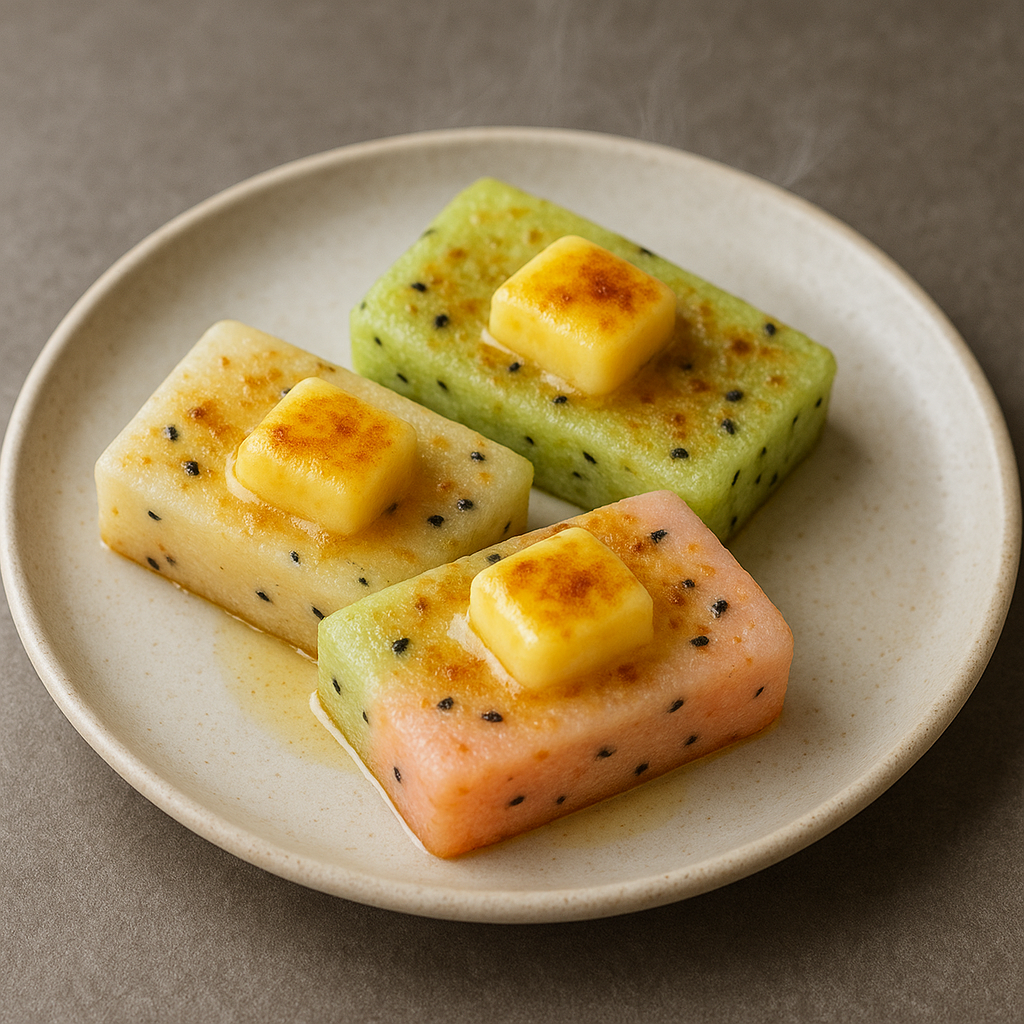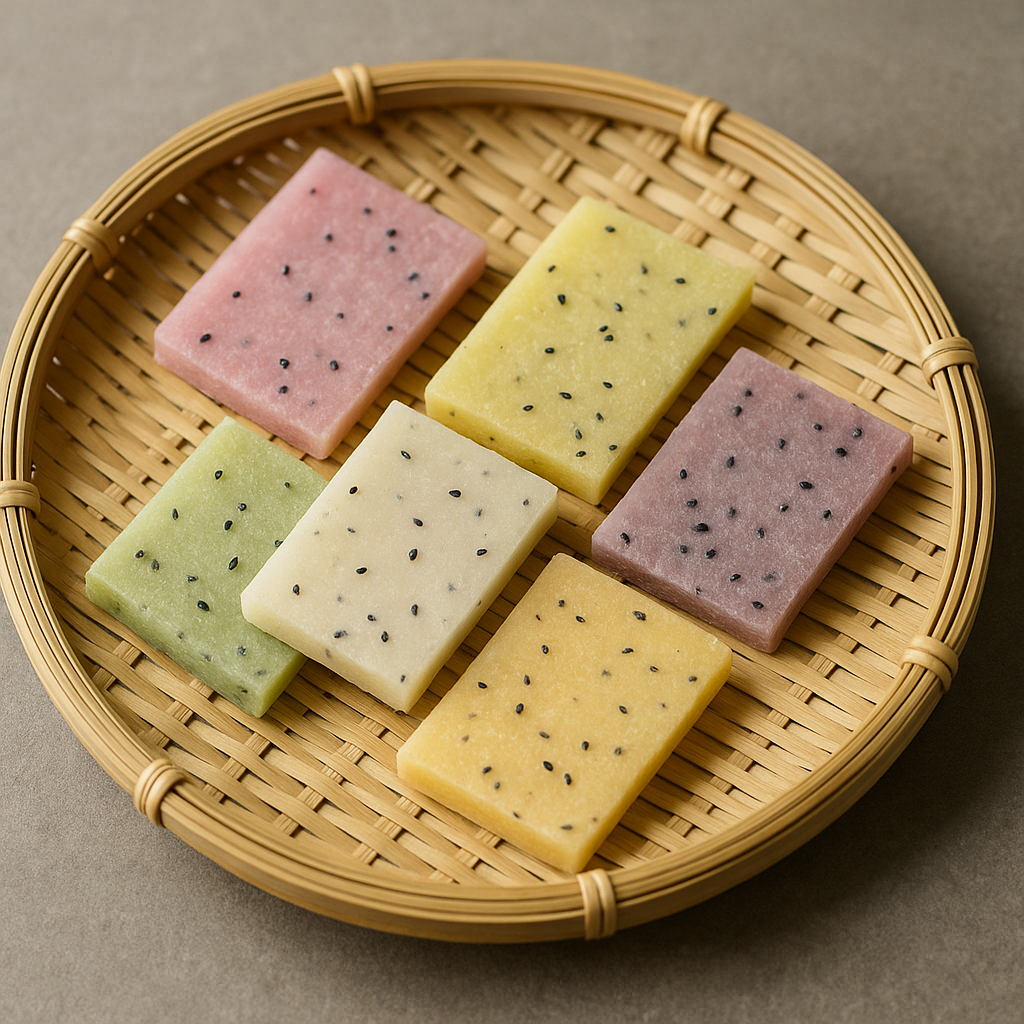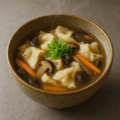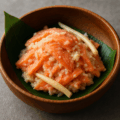
干し餅の特徴
冬の寒風で干して長く楽しむ、素朴な乾燥餅
干し餅は、ついた餅を薄く成形して寒風と乾燥で水分を抜いた保存菓子。軽く焼けば外カリッ・中もちっと、油で揚げれば香ばしいあられ風にもなります。
色や型で行事を彩る
白・紅(食紅)・よもぎ・黒ごま・青のりなどで色や風味を付け、輪切り・型抜き・串刺しにして干すのが定番。年取りや小正月の飾りにも用いられてきました。
「凍み餅」とのちがい
干し餅は主に風干しで乾燥させるのに対し、凍み餅は屋外で凍結と乾燥を繰り返して作るもの。どちらも保存性が高く、戻して煮たり焼いたりと用途が広いのが魅力です。
干し餅のレシピ
材料(作りやすい分量)
- もち米 … 1kg(または市販の切り餅でも可)
- 水 … 適量(浸水・蒸し用)
- 塩 … ひとつまみ(風味締め・任意)
- 〈彩り・風味〉食紅/よもぎ粉/黒ごま/青のり … 適量(任意)
- 打ち粉(片栗粉または上新粉) … 適量
- 紐・串・干し網 … 適宜(乾燥用)
作り方
- 餅をつく:もち米を6〜8時間浸水し、蒸して熱いうちにつき上げる(塩少々を加えると雑味が締まる)。
※切り餅を使う場合は、電子レンジや蒸し器で柔らかくしてまとめる。 - 成形:打ち粉をふり、1cm厚の板状にのばすか、直径3〜4cmの棒状にして落とし切りにする。型抜きも可。
- 乾燥:風通しのよい日陰に並べ、3〜7日を目安に乾かす(低温・乾燥が理想)。串に刺して吊るすと均一に乾きやすい。途中で上下を返す。
- 保存:完全に乾いたら密閉容器へ。湿気を避け、常温(涼所)または冷凍で保存。
食べ方(定番アレンジ)
- 焼く:弱めの中火で両面をこんがり。砂糖醤油やきな粉で。
- 揚げる:160〜170℃の油でふくらむまで。塩・青のり・七味などで。
- 砂糖湯:水+砂糖(好みで醤油少々)で軽く煮含めると、やさしい甘さの懐かしい味に。
シェフのワンポイントアドバイス
乾燥は低湿度&風通しが命。雨天や湿度が高い日は室内で扇風機+除湿を併用。食品乾燥機があるなら使用するのが無難。
カビ防止のため、最初の2日間は特に間隔をあけて並べましょう。
色付けは生地を分け、食紅はごく少量から。よもぎ・ごま・青のりは混ぜ込みすぎないと口当たりが軽く仕上がります。
栄養価(1枚〈乾燥30g〉の目安)
- エネルギー:約90〜130 kcal
- たんぱく質:1.5〜2.5 g
- 脂質:0.3〜1.0 g
- 炭水化物:20〜27 g
低脂質・高炭水化物のエネルギー源。熱いまま・大きいままは喉に詰まりやすいので、必ず小さく割り、よく噛んで食べましょう。
歴史
冬の保存と年取りの知恵
寒風が吹く時季に仕込み、長く楽しむための保存餅として各地に定着。年取りや小正月の飾り・ふるまいとしても親しまれてきました。
地域に残る多彩な姿
輪切りや型抜きの干し餅、凍結乾燥の凍み餅、色餅を串に刺して飾る花餅など、土地の気候と行事に根ざした多彩なバリエーションが受け継がれています。
English Version
Features of Hoshi-mochi (Dried Rice Cakes)
A simple dried rice cake cured in winter winds
Hoshi-mochi are pounded rice cakes shaped thin and air-dried in the cold winter wind. Lightly grilled, they turn crisp on the outside and chewy within; deep-fried, they become toasty, cracker-like bites.
Color and shape for festive displays
They’re often colored or flavored—white, red (food dye), mugwort, black sesame, or aonori—and dried as rings, cutouts, or on skewers. They decorate year-end (“Toshitori”) and Little New Year celebrations.
How it differs from “Shimi-mochi”
Hoshi-mochi is mainly air-dried, while shimi-mochi is made by repeated outdoor freezing and drying. Both keep well and can be rehydrated to simmer or simply grilled.
Hoshi-mochi Recipe
Ingredients (easy batch)
- Glutinous rice … 1 kg (or store-bought cut mochi)
- Water … as needed (soaking/steaming)
- Salt … a pinch (optional, to tighten flavor)
- Color/flavor (optional): red food dye / mugwort powder / black sesame / aonori … to taste
- Dusting starch (potato starch or rice flour) … as needed
- String, skewers, drying rack/net … as needed
Instructions
- Pound the mochi: Soak the glutinous rice 6–8 hours, steam, and pound while hot (a small pinch of salt helps sharpen the taste).
Using cut mochi? Soften in a steamer or microwave and knead together. - Shape: Dust the board and either roll to ~1 cm thick slabs or form 3–4 cm logs and slice into rounds. Cookie-cut shapes are fine, too.
- Dry: Lay in a breezy, shaded place and dry for 3–7 days (cool and low humidity are ideal). Skewering and hanging helps even drying; flip partway through.
- Store: Once fully dry, seal in an airtight container. Keep in a cool, dry spot or freeze.
How to Serve (classics)
- Grill: Toast gently on medium-low on both sides; finish with soy–sugar glaze or kinako.
- Fry: 160–170°C oil until puffed; season with salt, aonori, or shichimi.
- Sweet broth: Simmer briefly in water with sugar (and a dash of soy, if you like) for a nostalgic, gentle sweetness.
Chef’s Tips
Drying depends on low humidity and good airflow. On rainy or humid days, move indoors with a fan and dehumidifier—if you own a food dehydrator, it’s the safest option. To prevent mold, space pieces well, especially for the first two days. Divide the dough to color; use only a tiny amount of red dye. Don’t overmix mugwort, sesame, or aonori for a lighter bite.
Nutritional Value (per piece, ~30 g dried)
- Calories: about 90–130 kcal
- Protein: 1.5–2.5 g
- Fat: 0.3–1.0 g
- Carbohydrates: 20–27 g
Low in fat and rich in carbohydrates—an energy-dense snack. To avoid choking, never eat large or very hot pieces; break into small bites and chew thoroughly.
History
Winter preservation and year-end wisdom
Prepared during the cold, windy season to keep rice cakes longer, they became fixtures of year-end and Little New Year decorations and treats.
Regional diversity
From ring-cut and cookie-cut dried mochi to freeze-dried shimi-mochi and colorful “flower mochi” on skewers, forms vary with local climate and customs.



何でも質問してください!